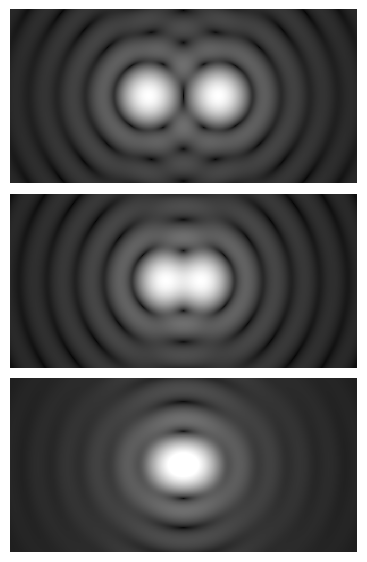|
Sparrow's Resolution Limit
Sparrow's resolution limit is an estimate of the angular resolution limit of an optical instrument. Rayleigh criterion When a star is observed with a telescope, the light is diffracted or spread apart into an Airy disk In optics, the Airy disk (or Airy disc) and Airy pattern are descriptions of the best- focused spot of light that a perfect lens with a circular aperture can make, limited by the diffraction of light. The Airy disk is of importance in physics, .... The resolution limit is defined as the minimum angular separation between two stars that can still be perceived as separate by an observer. The angular diameter of the Airy disk is determined by the aperture of the instrument. Rayleigh's resolution limit is reached when the two stars are separated by the theoretical radius of the first dark interval around the Airy disk, which is larger than the disk's apparent radius, so that a distinct dark gap appears between the two disks. Most astronomers say they can still di ... [...More Info...] [...Related Items...] OR: [Wikipedia] [Google] [Baidu] |
Angular Resolution
Angular resolution describes the ability of any image-forming device such as an optical or radio telescope, a microscope, a camera, or an eye, to distinguish small details of an object, thereby making it a major determinant of image resolution. It is used in optics applied to light waves, in antenna theory applied to radio waves, and in acoustics applied to sound waves. The colloquial use of the term "resolution" sometimes causes confusion; when an optical system is said to have a high resolution or high angular resolution, it means that the perceived distance, or actual angular distance, between resolved neighboring objects is small. The value that quantifies this property, ''θ,'' which is given by the Rayleigh criterion, is low for a system with a high resolution. The closely related term spatial resolution refers to the precision of a measurement with respect to space, which is directly connected to angular resolution in imaging instruments. The Rayleigh criterion shows th ... [...More Info...] [...Related Items...] OR: [Wikipedia] [Google] [Baidu] |
Airy Disk
In optics, the Airy disk (or Airy disc) and Airy pattern are descriptions of the best- focused spot of light that a perfect lens with a circular aperture can make, limited by the diffraction of light. The Airy disk is of importance in physics, optics, and astronomy. The diffraction pattern resulting from a uniformly illuminated, circular aperture has a bright central region, known as the Airy disk, which together with the series of concentric rings around is called the Airy pattern. Both are named after George Biddell Airy. The disk and rings phenomenon had been known prior to Airy; John Herschel described the appearance of a bright star seen through a telescope under high magnification for an 1828 article on light for the ''Encyclopedia Metropolitana'': Airy wrote the first full theoretical treatment explaining the phenomenon (his 1835 "On the Diffraction of an Object-glass with Circular Aperture"). Mathematically, the diffraction pattern is characterized by the wavelen ... [...More Info...] [...Related Items...] OR: [Wikipedia] [Google] [Baidu] |
Rayleigh Criterion
Angular resolution describes the ability of any image-forming device such as an optical or radio telescope, a microscope, a camera, or an eye, to distinguish small details of an object, thereby making it a major determinant of image resolution. It is used in optics applied to light waves, in antenna theory applied to radio waves, and in acoustics applied to sound waves. The colloquial use of the term "resolution" sometimes causes confusion; when an optical system is said to have a high resolution or high angular resolution, it means that the perceived distance, or actual angular distance, between resolved neighboring objects is small. The value that quantifies this property, ''θ,'' which is given by the Rayleigh criterion, is low for a system with a high resolution. The closely related term spatial resolution refers to the precision of a measurement with respect to space, which is directly connected to angular resolution in imaging instruments. The Rayleigh criterion shows th ... [...More Info...] [...Related Items...] OR: [Wikipedia] [Google] [Baidu] |
Dawes' Limit
Dawes' limit is a formula to express the maximum resolving power of a microscope or telescope. It is so named after its discoverer, W. R. Dawes ,Dawes, W.R., ''Catalogue of Micrometrical Measurements of Double Stars.'' In: Memoirs of the Royal Astronomical Society, Vol. 35, p.137 1867, although it is also credited to Lord Rayleigh. The formula takes different forms depending on the units. See also *Rayleigh criterion Angular resolution describes the ability of any image-forming device such as an optical or radio telescope, a microscope, a camera, or an eye, to distinguish small details of an object, thereby making it a major determinant of image resolution. ... References Optics {{Optics-stub ... [...More Info...] [...Related Items...] OR: [Wikipedia] [Google] [Baidu] |

